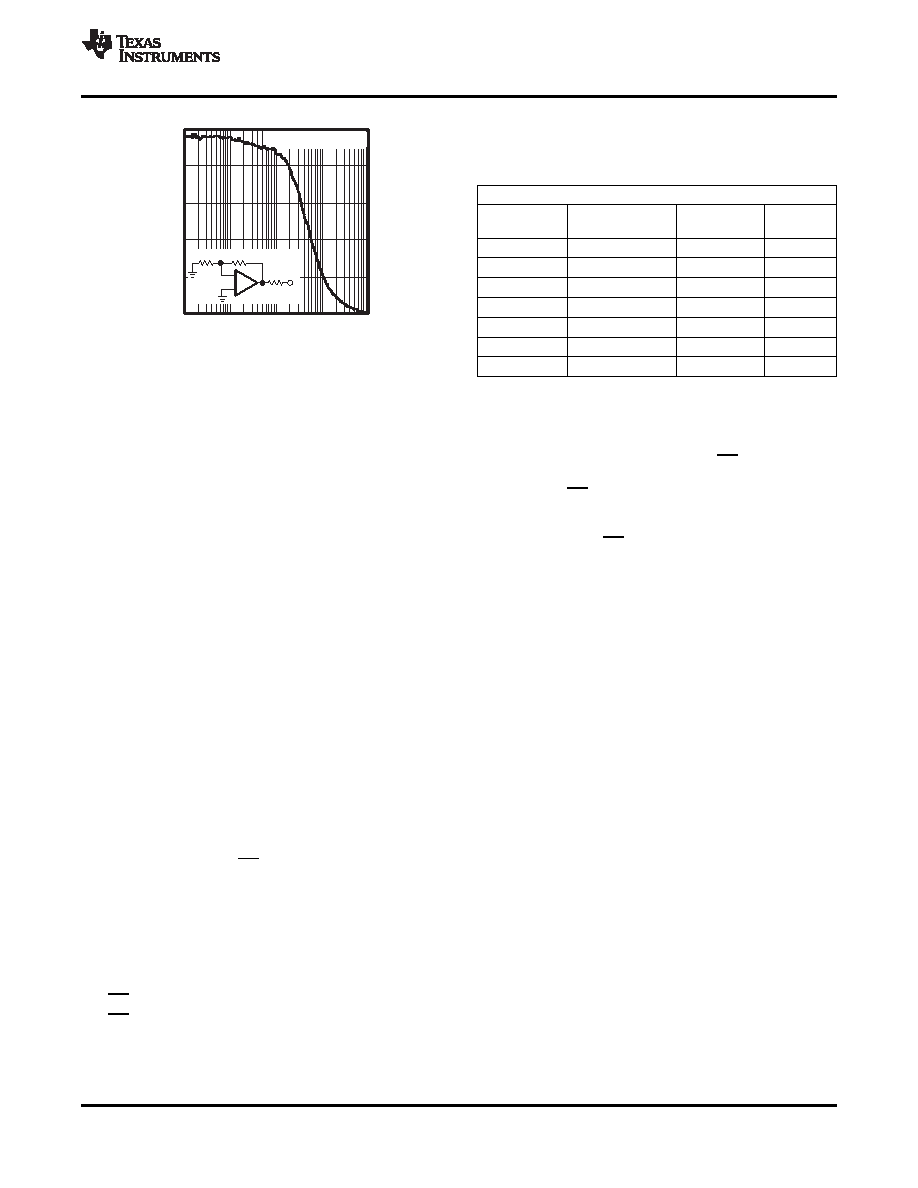- 您現(xiàn)在的位置:買賣IC網(wǎng) > PDF目錄98220 > THS3091DR (TEXAS INSTRUMENTS INC) 1 CHANNEL, VIDEO AMPLIFIER, PDSO8 PDF資料下載
參數(shù)資料
| 型號: | THS3091DR |
| 廠商: | TEXAS INSTRUMENTS INC |
| 元件分類: | 音頻/視頻放大 |
| 英文描述: | 1 CHANNEL, VIDEO AMPLIFIER, PDSO8 |
| 封裝: | GREEN, PLASTIC, MS-012AA, SOIC-8 |
| 文件頁數(shù): | 14/37頁 |
| 文件大?。?/td> | 1078K |
| 代理商: | THS3091DR |
第1頁第2頁第3頁第4頁第5頁第6頁第7頁第8頁第9頁第10頁第11頁第12頁第13頁當(dāng)前第14頁第15頁第16頁第17頁第18頁第19頁第20頁第21頁第22頁第23頁第24頁第25頁第26頁第27頁第28頁第29頁第30頁第31頁第32頁第33頁第34頁第35頁第36頁第37頁

0
500
1000
1500
2000
2500
100 k
1 M
10 M
100 M
1 G
+
1.21 k
1.21 k
50
VO
f Frequency Hz
Powerdown
Output
Impedance
Z
OPD
VS = ±15 V and ±5 V
PRINTED-CIRCUIT BOARD LAYOUT
POWER-DOWN REFERENCE PIN
www.ti.com........................................................................................................................................ SLOS423G – SEPTEMBER 2003 – REVISED OCTOBER 2008
The recommended mode of operation is to tie the
REF pin to midrail, thus setting the enable/disable
thresholds to Vmidrail + 2.0 V and Vmidrail + 0.8 V
respectively.
POWER-DOWN THRESHOLD VOLTAGE LEVELS
SUPPLY
REFERENCE PIN
ENABLE
DISABLE
VOLTAGE (V)
LEVEL (V)
±15, ±5
0.0
2.0
0.8
±15
2.0
4.0
2.8
±15
–2.0
0.0
–1.2
±5
1.0
3.0
1.8
±5
–1.0
1.0
–0.2
+30
15
17
15.8
Figure 70. Power-Down Output Impedance vs
+10
5.0
7.0
5.8
Frequency
Note that if the REF pin is left unterminated, it will
float to the positive rail and will fall outside of the
As with most current feedback amplifiers, the internal
recommended operating range given above (VS– ≤
architecture places some limitations on the system
VREF
≤ VS+ – 4 V). As a result, it will no longer serve
when in power-down mode. Most notably is the fact
as a reliable reference for the PD pin and the
that the amplifier actually turns ON if there is a ±0.7 V
enable/disable thresholds given above will no longer
or greater difference between the two input nodes
apply. If the PD pin is also left unterminated, it will
(V+ and V–) of the amplifier. If this difference
also float to the positive rail and the device will be
exceeds ±0.7 V, the output of the amplifier creates an
enabled. If balanced, split supplies are used (±Vs)
output voltage equal to approximately [(V+ – V–) –0.7
and the REF and PD pins are grounded, the device
V] × Gain. This also implies that if a voltage is applied
will be disabled.
to the output while in power-down mode, the V– node
voltage is equal to VO(applied) × RG/(RF + RG). For low
gain configurations and a large applied voltage at the
TECHNIQUES FOR OPTIMAL
output, the amplifier may actually turn ON due to the
PERFORMANCE
aforementioned behavior.
Achieving
optimum
performance
with
a
The time delays associated with turning the device on
high-frequency
amplifier,
like
the
THS3091/5,
and off are specified as the time it takes for the
requires careful attention to board layout parasitic and
amplifier to reach either 10% or 90% of the final
external component types.
output voltage. The time delays are in the order of
microseconds because the amplifier moves in and out
Recommendations that optimize performance include:
of the linear mode of operation in these transitions.
Minimize parasitic capacitance to any ac ground
for all of the signal I/O pins. Parasitic capacitance
on the output and input pins can cause instability.
OPERATION
To reduce unwanted capacitance, a window
around the signal I/O pins should be opened in all
In addition to the power-down pin, the THS3095
of the ground and power planes around those
features a reference pin (REF) which allows the user
pins. Otherwise, ground and power planes should
to control the enable or disable power-down voltage
be unbroken elsewhere on the board.
levels applied to the PD pin. In most split-supply
applications, the reference pin is connected to
Minimize the distance [< 0.25 inch (6,35 mm)]
ground. In either case, the user needs to be aware of
from the power supply pins to high-frequency
voltage-level thresholds that apply to the power-down
0.1-
F and 100-pF decoupling capacitors. At the
pin. The tables below show examples and illustrate
device pins, the ground and power plane layout
the relationship between the reference voltage and
should not be in close proximity to the signal I/O
the power-down thresholds. In the table, the threshold
pins. Avoid narrow power and ground traces to
levels are derived by the following equations:
minimize inductance between the pins and the
decoupling
capacitors.
The
power
supply
PD
≤ REF + 0.8 V for disable
connections should always be decoupled with
PD
≥ REF + 2.0 V for enable
these
capacitors.
Larger
(6.8
F or more)
where the usable range at the REF pin is
tantalum decoupling capacitors, effective at lower
frequency, should also be used on the main
VS– ≤ VREF ≤ (VS+ – 4 V).
supply pins. These may be placed somewhat
Copyright 2003–2008, Texas Instruments Incorporated
21
相關(guān)PDF資料 |
PDF描述 |
|---|---|
| THS3091D | 1 CHANNEL, VIDEO AMPLIFIER, PDSO8 |
| THS3091DRG4 | 1 CHANNEL, VIDEO AMPLIFIER, PDSO8 |
| THS3091DG4 | 1 CHANNEL, VIDEO AMPLIFIER, PDSO8 |
| THS3091DDARG3 | 1 CHANNEL, VIDEO AMPLIFIER, PDSO8 |
| THS3091DDAG3 | 1 CHANNEL, VIDEO AMPLIFIER, PDSO8 |
相關(guān)代理商/技術(shù)參數(shù) |
參數(shù)描述 |
|---|---|
| THS3091DRG4 | 功能描述:高速運算放大器 Single Lo-Distort Current Feedback RoHS:否 制造商:Texas Instruments 通道數(shù)量:1 電壓增益 dB:116 dB 輸入補償電壓:0.5 mV 轉(zhuǎn)換速度:55 V/us 工作電源電壓:36 V 電源電流:7.5 mA 最大工作溫度:+ 85 C 安裝風(fēng)格:SMD/SMT 封裝 / 箱體:SOIC-8 封裝:Tube |
| THS3091EVM | 功能描述:放大器 IC 開發(fā)工具 THS3091 Eval Module RoHS:否 制造商:International Rectifier 產(chǎn)品:Demonstration Boards 類型:Power Amplifiers 工具用于評估:IR4302 工作電源電壓:13 V to 23 V |
| THS3092 | 制造商:TI 制造商全稱:Texas Instruments 功能描述:HIGH-VOLTAGE, LOW-DISTORTION, CURRENT-FEEDBACK OPERATIONAL AMPLIFIERS |
| THS3092D | 功能描述:高速運算放大器 Dual Hig-Vltg Low Distortion RoHS:否 制造商:Texas Instruments 通道數(shù)量:1 電壓增益 dB:116 dB 輸入補償電壓:0.5 mV 轉(zhuǎn)換速度:55 V/us 工作電源電壓:36 V 電源電流:7.5 mA 最大工作溫度:+ 85 C 安裝風(fēng)格:SMD/SMT 封裝 / 箱體:SOIC-8 封裝:Tube |
| THS3092DDA | 功能描述:高速運算放大器 Dual Hig-Vltg Low Distortion RoHS:否 制造商:Texas Instruments 通道數(shù)量:1 電壓增益 dB:116 dB 輸入補償電壓:0.5 mV 轉(zhuǎn)換速度:55 V/us 工作電源電壓:36 V 電源電流:7.5 mA 最大工作溫度:+ 85 C 安裝風(fēng)格:SMD/SMT 封裝 / 箱體:SOIC-8 封裝:Tube |
發(fā)布緊急采購,3分鐘左右您將得到回復(fù)。